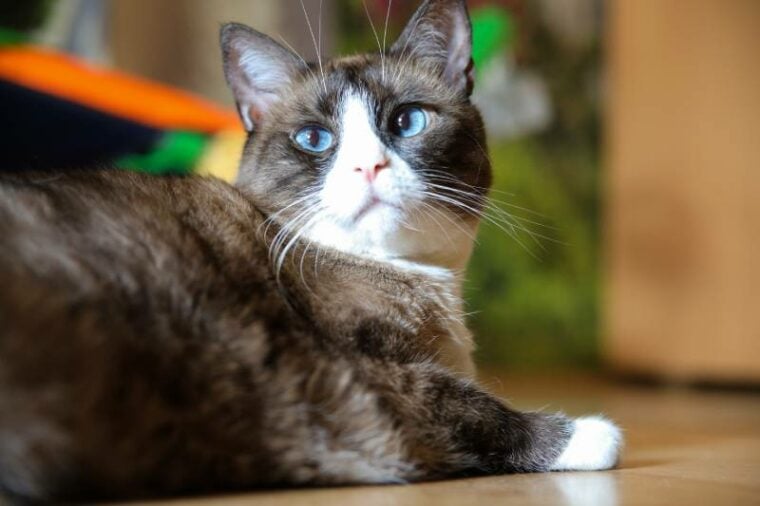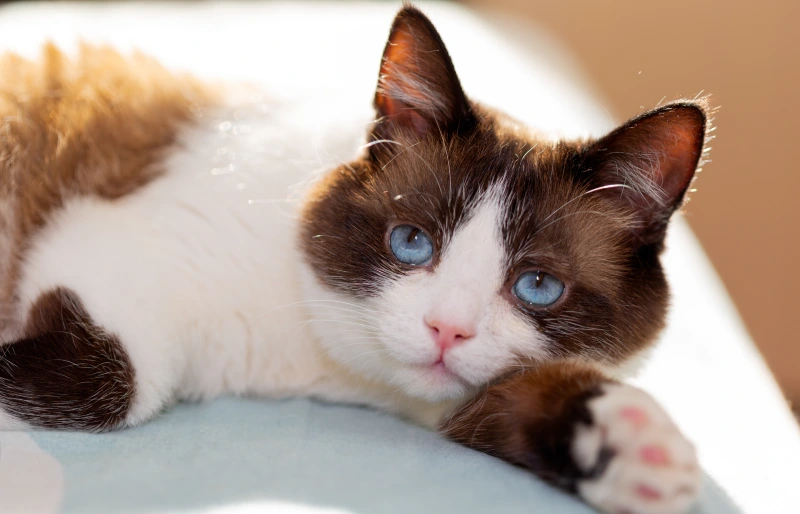
Click to Skip Ahead
The beautiful Snowshoe cat was developed in Pennsylvania. Two Siamese cats produced a litter of kittens for Dorothy Hinds Docherty in the 1960s, three of which had white feet. They started the Snowshoe cat, whose sleek fur is not hypoallergenic despite only being a single coat.
The coat of the Snowshoe cat is beautifully marked, and white is the predominant color. These single-coated cats are low-shedders, and their grooming requirements are minimal. However, that doesn’t make them suitable for allergy sufferers.
While the lower shedding of the Snowshoe may make them more tolerable for people suffering from pet allergies, they still produce the allergen that causes a reaction.
What Causes a Cat Allergy?
Cat allergies are often thought to be caused by cat fur, and single-coated, low-shedding, or hairless breeds are mislabeled as being hypoallergenic. This is a common misconception; people with pet allergies are allergic to a protein in the cat’s saliva, sebum, and urine.
The Fel D 1 protein is the culprit, which is found primarily in the sebaceous (sebum glands) and salivary glands of the cat. Humans produce a specific antibody to cat allergens called IgE, which is triggered by the Fel D 1 protein. In people allergic to cats, this causes an immune response and a histamine release; this process causes the symptoms we associate with allergies.
Cat fur, dander (dead skin), and saliva are what people most likely come into contact with when interacting with cats. People who are allergic to cats can even get a reaction from an environment a cat has been in, thanks to fur and dander shedding! That is why cats like the Snowshoe (that shed less than other breeds) are often mistaken as hypoallergenic.

How Do I Know I’m Allergic to My Snowshoe Cat?
If you’ve been reacting to your Snowshoe or their fur, you might wonder whether or not you’re allergic to them. There are different symptoms people can show when suffering from a cat allergy, ranging from mild to severe.
There are treatments available if you suffer from a cat allergy, but advice should be sought from your doctor if you have any concerns you might be allergic.
The Meaning of Hypoallergenic
Hypoallergenic means “less likely to cause an allergic reaction.” This is different from anallergenic, which means “will not cause an allergic reaction”. This is where some people get confused when looking for cats that are good for allergy sufferers. Snowshoe cats are not hypoallergenic nor anallergenic (no cats are), and they are likely to cause a reaction in those with allergies.
Some breeds shed less of the allergen than others, however. They produce less Fel D 1 protein or shed less dander, making them more friendly for people with cat allergies.

Why Are Snowshoe Cats Not Hypoallergenic?
While they’re beautiful and intelligent cats, Snowshoes can still affect those with cat allergies. Snowshoes shed less fur due to their single coats, but they still shed the allergen (Fel D 1), which shows up in fur, dander, and saliva.
Final Thoughts
Snowshoe cats are sleek and single-coated, and they don’t have an underlayer in their fur. While less shedding makes cleaning up after them easier, it, unfortunately, doesn’t stop them from producing the protein that causes reactions in people with cat allergies.
The Fel D 1 protein is produced in sebum and saliva glands in cats, and some breeds (such as the Russian Blue) produce less of the protein. While no cats are truly hypoallergenic, they are more suitable for people with cat allergies!
Featured Image Credit: Aleksandar Nalbantjan, Shutterstock






